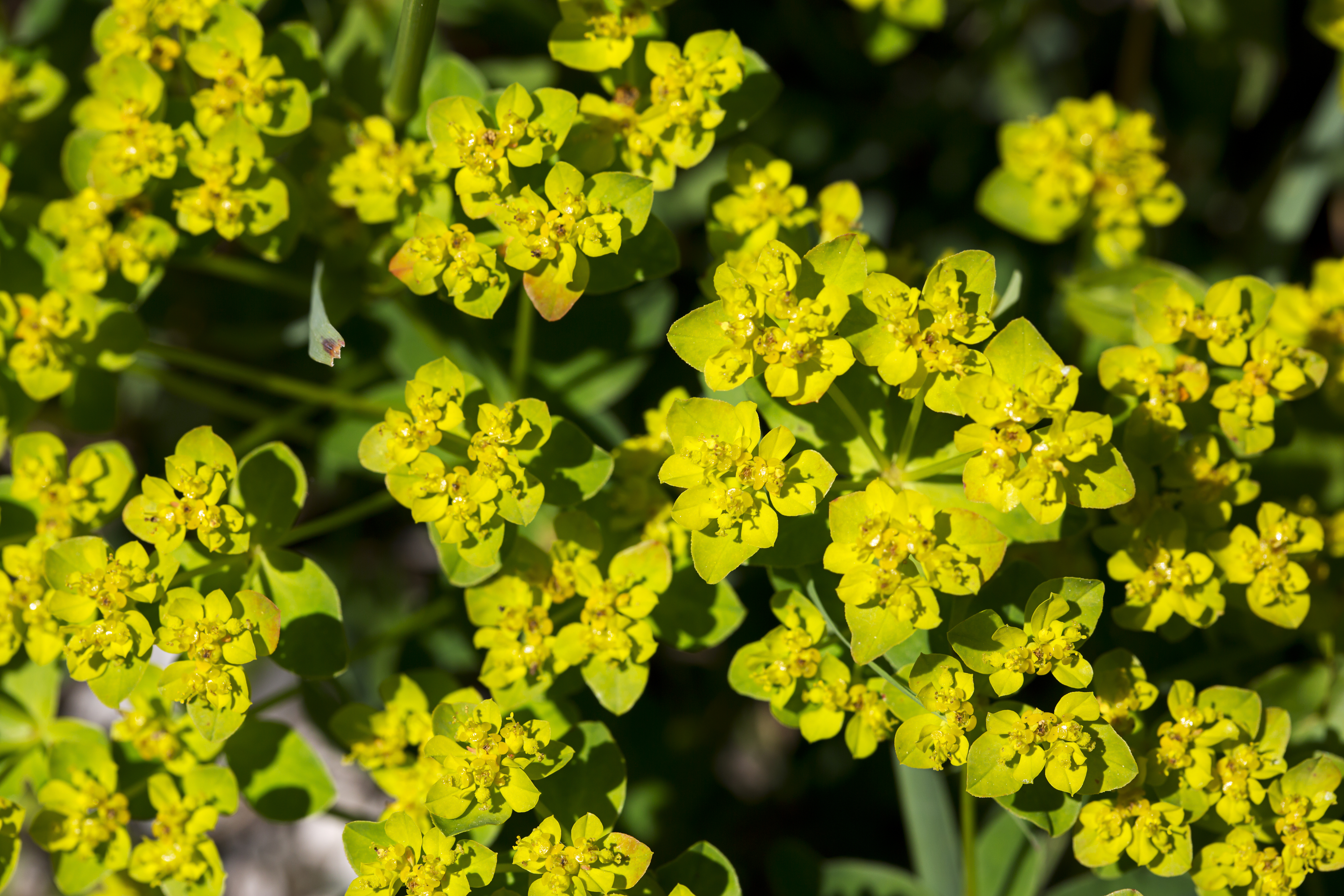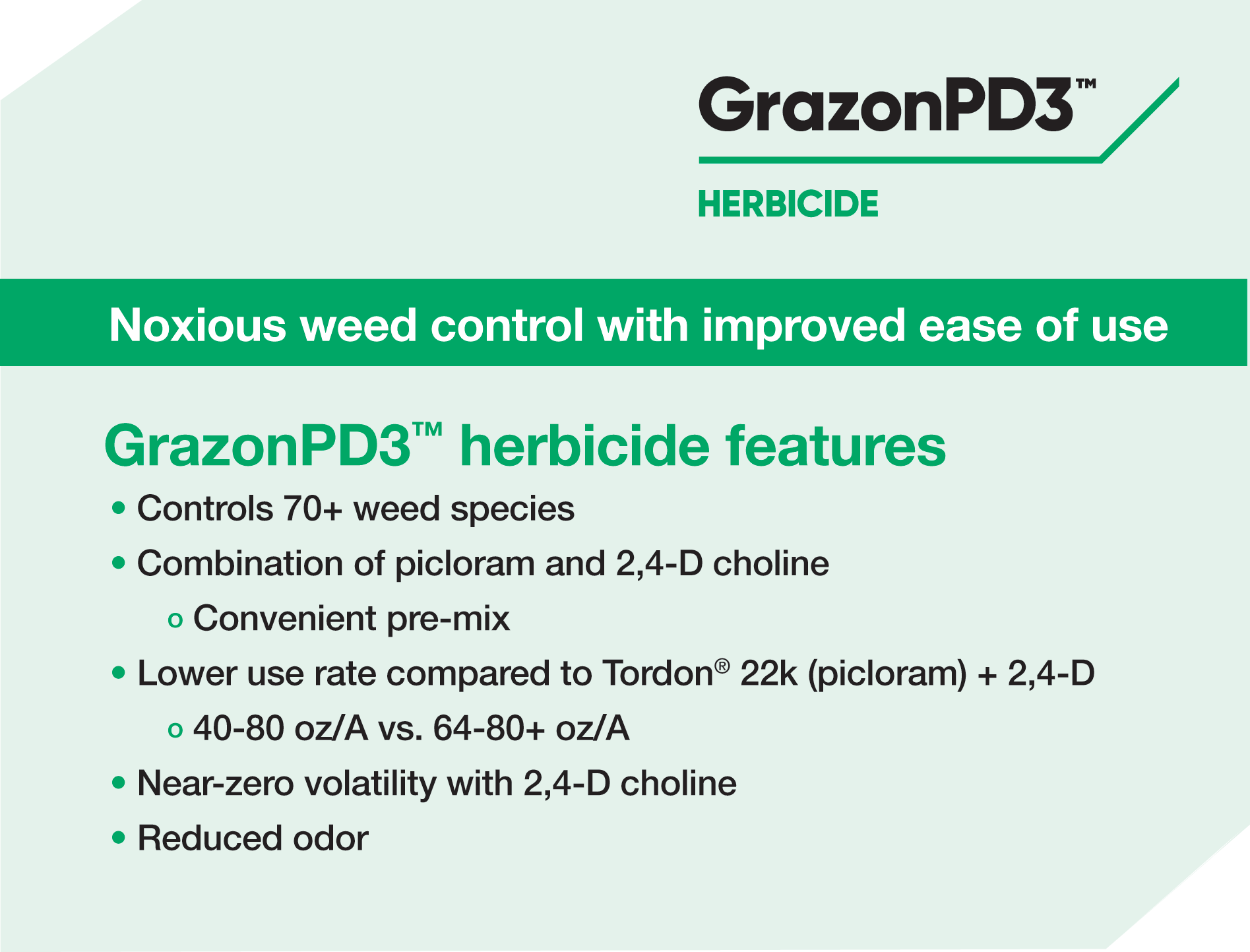Gaining Experience with a User-Friendly Option for Leafy Spurge Control

In Weston County, Wyoming, they’ve been working to control leafy spurge since the mid-1990s. In an area that’s primarily home to ranches, livestock production and oil fields, partnership with private landowners to address invasive vegetation like this is vital. A cost-sharing program has made it easier for landowners here to treat for leafy spurge on their land. Since 2008, the county has also benefitted from a grant that covers aerial applications. This is important in a vast, variable landscape that also includes recreational areas in the Black Hills and Thunder Basin National Grasslands.
Leafy spurge is among several noxious weeds that pose a special challenge in western lands like Weston County. Leafy spurge roots can penetrate more than 4 meters into the soil, robbing native plants of water and space to grow. The weed also produces seed pods that, when ripe, explode and scatter seeds as far as 15 feet away, which allows infestations to grow rapidly. Leafy spurge produces a sap that can be toxic to some animals. While most livestock naturally avoid grazing on the plant, the sap can cause blistering around horses’ hooves and can be irritating to humans. The USDA notes that leafy spurge reduces habitat for bison, elk and deer.1

Leafy spurge has deep root systems and wide-spreading seeds, making it a difficult noxious weed to control.
Leafy spurge is just one of the invasive weeds the county has to actively control across its 2,400 square-mile area. “Our main programs focus on leafy spurge, hoary cress, Canada thistle, Russian and spotted knapweed, and several other species of smaller infestation sizes,” explained Hale Redding, District Supervisor, Weston County Weed and Pest Control District. “We currently have two aerial programs for treatment of hoary cress and leafy spurge along with using ground crews to treat areas where aerial treatment isn’t feasible or in sensitive areas.”
Redding said aerial applications have been key to increasing the scale and continuity of their leafy spurge program. The District also works with landowners on a variety of management practices. “We have a goat grazing program for targeted infestations,” Redding explained. “We have several landowners in the program who are starting to see pretty good results with grazing alone. And one participant that is using grazing and chemical treatments combined is seeing very good results.”
Like all public weed and pest control offices, Weston County needs to make the best use of limited time and resources to care for a huge area that’s important economically and ecologically. New tools that make weed control easier and reduce environmental impact are welcome.
For 2024, Redding and his team have decided to try a new solution for leafy spurge treatment, GrazonPD3™ herbicide from Corteva Agriscience. GrazonPD3 combines two very familiar active ingredients — 2,4-D and picloram — in a user-friendly formulation.
“The program has largely used Tordon 22K as the main chemistry for leafy spurge treatments,” Redding said. “We have found picloram and imazapic both work well in managing leafy spurge infestations over the years. Timing is critical in fall treatments with imazapic to get the desired results. Picloram is a little more forgiving as far as application timing. Rainfall and wind are always our biggest challenges.”
Although the county’s program has been working well, when Redding heard about GrazonPD3, he was interested. “With the lower rate of picloram and the addition of [2,4-D choline], we are excited to see if we get increased control compared to just using picloram.”
Tordon® 22K herbicide is known for its outstanding control of leafy spurge. GrazonPD3 maintains that efficacy with a lower use rate of picloram and the convenience of a premix with 2,4-D. Typical applications that combine Tordon 22K and 2,4‑D as separate ingredients result in a use rate of 64-80 ounces/A, or more. With GrazonPD3, the volume is 40-80 ounces/A depending on targeted weed species. While the Weston County efforts are targeting leafy spurge in particular, GrazonPD3 is labeled for more than 70 broadleaf weed species, with notable performance against bindweed as well.
GrazonPD3 is also formulated with 2,4-D choline, which has inherently near-zero volatility. 2,4-D choline is 96% less volatile than 2,4-D ester. With aerial applications over wide areas, volatility is a big concern. Applicators have to be vigilant about volatile herbicides traveling and harming susceptible crops like alfalfa, or damaging home gardens in nearby communities. This gives applicators using GrazonPD3 additional peace of mind, and confidence that the product will stay put to address targeted weeds.
GrazonPD3 offers improved handling with lower odor, too — a feature appreciated by applicators, landowners and communities.

The Weston County Weed and Pest Control District completed their first application of GrazonPD3™ herbicide in June 2024. “We did an aerial application with a helicopter at a use rate of 64 ounces per acre,” Redding said. Application went well, although wind shut things down for a few days — a common issue in Wyoming. Redding noted, however, that “The [GrazonPD3] formulation is stickier than straight picloram,” which is helpful in the presence of air movement.
Redding had one piece of advice for other weed management services looking to try GrazonPD3. “We ordered the product in two-gallon jugs thinking it would be easier to handle on the helicopter versus a 265-gallon tote,” he said. “In the future, we’d probably use a tote instead because it takes up less space. Plan accordingly and consult with your aerial applicator when making those decisions.”
At the time of this article’s publication, the Weston County team had recently finished aerial application. Redding said, “We’re getting ready to start monitoring the spray blocks and will be looking for indications of effective treatments in the areas we sprayed.” He said monitoring will continue into the fall. “There will possibly be some intensive grazing treatments in these areas and also some ground treatments in areas that were not accessible from the aircraft.”
The TechLine team will be following up with Redding on results from this year’s application effort and ongoing control of leafy spurge and other invasives in the area. Redding is optimistic about what he expects to see. “GrazonPD3 is a great option for the treatment areas where we’ve used it — large, open areas with very few trees to worry about. The 2,4-D choline aids in the burndown of the treated plants and will give a better indication of effective treatments for landowners to see.”
1 St. John, Loren, and Derek Tilley. “Plant Guide for Leafy Spurge (Euphorbia Esula).” USDA PLANTS Database, January 2014. https://plants.usda.gov/DocumentLibrary/plantguide/pdf/pg_eues.pdf.
GrazonPD3™ and Tordon® 22K are Restricted Use Pesticides. GrazonPD3 and Tordon 22K are not registered for sale or use in all states. Contact your state pesticide regulatory agency to determine if a product is registered for sale or use in your state. Always read and follow label directions.
Sharing innovative research, success stories and tips with invasive plant managers.